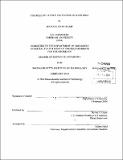The role of lattice excitation in Si etching
Author(s)
Blair, Michael Ryan
DownloadFull printable version (17.35Mb)
Other Contributors
Massachusetts Institute of Technology. Department of Chemistry.
Advisor
Sylvia T. Ceyer.
Terms of use
Metadata
Show full item recordAbstract
The chemistries of fluorine, F₂, and xenon difluoride, XeF₂, with clean Si are basically the same, while their chemistries diverge dramatically past I ML F coverage. With a clean Si surface, F₂ and XeF₂ react utilizing an atom abstraction mechanism, where a surface dangling bond abstracts a F atom from the incident molecule, scattering the F atom or XeF fragment into the gas phase. Past 1 ML coverage, further exposure to F₂ results in no increase in F coverage, indicating that reaction of F₂ with the fluorinated Si surface does not occur. In contrast, further exposure to XeF₂ results in additional reaction, increasing the coverage sufficiently beyond 1 ML F to produce the volatile etch product, SiF 4. The experiments described in this thesis explain the observed difference in reactivity of F₂ and XeF₂ with a fluorinated Si surface as vibrational excitation of the Si lattice, induced by the initial collisions of XeF₂ with the surface that enable a barrierless reaction of the fluorine carried on the Xe with the Si-Si bonds of the surface or lattice. The possibility of enhancement of the reactivity of F₂ by vibrational excitation of the fluorinated Si lattice is studied using the van der Waals dimer Kr(F₂). Kr(F₂) is produced by coexpansion of F₂ and Kr in a molecular beam. It has the mass of bound KrF₂ with the chemical properties of F₂. Any increase in Si reactivity using Kr(F₂) compared to that of F₂ can be attributed to the mass of the molecule, since the dimer is basically a heavy F₂ molecule. After exposure of the fluorinated Si to Kr(F₂) molecules, the final F coverage is measured. With an estimate of Kr(F₂) exposure already calculated, the reaction probability is then found. The Kr(F₂) species is shown to have a reaction probability (Pads = 0.04) that is several orders of magnitude greater than that measured for F₂ (Pads ~10-4) and around 20 times less than that for XeF₂ (Pads = 0.9.) A simple classical model is presented to explain the reactivity difference of F₂ and XeF₂ with Si. Using simulation, the amount of energy transferred by a given mass to the Si surface, along with number of collisions and Si lattice excitation time, is determined. From the simulation, XeF₂ suffers 2-3 more collisions with Si than does F₂ . Since more collisions are occurring using XeF₂, the Si lattice is deformed for a longer period of time. Therefore, the Si-Si lattice bonds are stretched and compressed for a longer period of time, an advantageous situation for further reaction with the fluorine bound to the Xe. Excitation of the surface lattice may play a role in the reactivities of XeF₂ and F₂ with Si. This mechanism has not been fully investigated previously, and may account for the large difference in reactivity that is observed for these species. This study shows for the first time that the energy transferred to a surface as a result of a molecule's initial collision with it plays a critical role in the reaction probability in a molecule-surface interaction. Furthermore, this mechanism should apply to other semiconductor etchants, and must be considered in future kinetic models of such etchant systems.
Description
Thesis: S.M., Massachusetts Institute of Technology, Department of Chemistry, 2014. Cataloged from PDF version of thesis. Vita. Includes bibliographical references.
Date issued
2014Department
Massachusetts Institute of Technology. Department of ChemistryPublisher
Massachusetts Institute of Technology
Keywords
Chemistry.